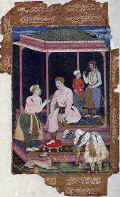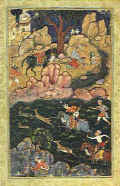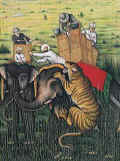|
Overview
Indian paintings provide an aesthetic continuum that extends from the early
civilization to the present day. This form of art in India is vivid and lively,
refined and sophisticated and bold and vigorous at the same time. From being
essentially religious in purpose in the beginning, Indian paintings have evolved
over the years to become a fusion of various traditions which influenced them.
Murals
During the 4th century AD. in a remote valley in Western India, work began on
the Ajanta caves to create a complex of Buddhist monasteries and prayer halls.
The sculptor-monks who lived here during the months of rain also took up a novel
exercise of painting large tempera murals on the walls of the caves. The walls
and ceilings were painted with frescoes in vibrant mineral colors. These
paintings turned out to be of a quality which has never been surpassed.
The themes of these wall-paintings range from Buddhist legends to decorative
patterns of flowers and animals. They seek to depict permanent human values and
principles and are also records of the social texture of the times. The Golden
Age of India under the Mauryan Empire was marked by luxurious living and
splendor. The Ajanta murals were painted during this time of prosperity.
These murals also formed the basis of an entire aesthetic tradition which
later spread to other countries in Asia. Versatility of line and form and role
of color and composition are the endearing features of this art form. These
paintings create a feeling of gaiety, wonder and resonance in the beholder. The
viewer is transported into another state of consciousness where sound and light
and color and palpable form are fused into one separate reality.
Miniatures
The essence of the Indian miniaturists' visual expression lay in the idea of
symbolism. In the language of symbols they recorded their communion with nature,
rich in wonder, awe and delight. Their minds excelled in expressing what lay
beyond the primary function of lines and pigments. 'The master painter disposes',
Buddha once remarked while alluding to the art of metaphysical teaching, 'his colors for the sake of a picture that can not be seen in the
colors
themselves.'
Painters delighted in unfolding the other dimension of the object; the basic
shift in emphasis was from the multiplicity of sense experiences to unifying
ideas, from the mutable aspect to an ever-present situation. Subjects derived
from myths served as the base for such a transformation of nature into art, to
reveal aspects of existence, human and supernatural or divine.
Indian miniature painting is a 'visual chamber music' to be savored slowly,
intently and privately. 'Miniature' generally refers to a painting or
illumination, small in size meticulous in detail and delicate in brushwork. The
art of palm-leaf illuminations were traditionally labeled as patra-lekhana
in medieval Indian canons. But later a generalized term pata chitra was
conveniently used to define other kinds of painting than wall painting. It
indeed included painted scrolls and panels.
Yet these paintings are not detached visions of artistic expression but
provide the basis of Indian music and art forms. Most of these masterly works
are visual creations of emotional and perceptive concepts that depict the ragas
or musical modes of Indian classical music. Miniature painters employed at
various medieval courts, discovered the potential of limitless self-expression
in their depiction and today there are 130 known sets of such miniatures.
These pictorially articulate visions of art first made their appearance in
the Indian cultural scene in the 5th century. The artist drew his inspiration
from a musical text called Narada Shiksha. But while the text dates back
to the early beginnings of art, its artistic depiction did not gain credence
till about a hundred years later, when artists and painters took cognizance of
the relationship that governs sound and sentiment. This art form soon generated
into a dynamic movement, fanned by patronage and fulfilled itself into
figurative and pastoral scenes, making music the subject matter of art, through color
and mood.
These beautiful paintings also depict the court life of the time when they
were created. The raiment of the figures, the architecture of the land, the
features of the faces come into sharp focus under the painter's lyrical eye. The
thematic stance has given the works a certain uniformity, a decided formalism
and a feel of the glory and grandeur of the times. The gossamer-veiled women
with pinched noses, doe-eyes and graceful stances are not just an art form, but
become a basis for appreciating the charm of a bygone era.
Yet within this uniform diffusion of compositional selection, there are
distinct differences. These are due to the different schools of art. The Persian
influence upon the Indian folk, or the workmanship of one court artist or
another, have given this trove of paintings a varied content. The schools of
Mewar or Udaipur or Jaipur in Rajasthan have incorporated their desert landscape
and architecture. The hill kingdoms of Kumaon and Kangra are marked by fine
drawing, while the plateau regions of Malwa and Bundelkhand specialize in
attractive brush work. The crowning glory of the miniature series is the
Provincial Mughal works, attributed to the reign of emperors Akbar and Jehangir.
These depict the rulers themselves as well as historical personages and
musicians. The Tanjore paintings of the South depict Krishna and Shiva and
reflect the mythical source of music.
Folk Painting
The somewhat lesser-known traditions of Indian painting are the so-called
"folk" paintings dating back to a period that may be referred to as
"timeless". These are living traditions, intrinsically linked with the
regional historic-cultural settings from which they arise
With the arrival of the British, Indian painting took a new turn. This period
saw the emergence of an Indo-European genre of painting known as the Company
style. It was only with the rise of political consciousness that Indian art came
into its own, once again.
Two prominent names which figure in 20th century Indian art are Amrita
Shergil - a woman trained in Paris, and Rabindranath Tagore. In this period,
Indians were not only fighting for political independence, but were also
liberating themselves from their traditional mind-sets and trappings. Much of
the art of this era depicts this newly emerging social consciousness.
Independence saw the setting up of a new school of art in Bombay, called the
Progressive Artists Group. The prominent artists of this group are Francis
Newton Souza the founder, and Maqbool Fida Husain. Painting took a new form in
this period - bold and furious at one end, soft and magical at the other. Gulam
Muhammed Sheikh, Bhupen Khakkar and Sundaram are some other names featuring in
India's contemporary art scene. Most contemporary Indian paintings contain
imagery that is literal and color that is highly charged, creating a
kaleidoscope of humanity and the human condition in modern India.
The Indian paintings have now acquired a stature of their own. They use
materials and techniques from all over the world but express Indian realities
and Indian experiences. The respect for tradition and the ability to transcend
it at the same time is clearly evident in Indian art of today. This is the
essence of what has been described as the eclecticism of the Indian contemporary
expression.
Other
Related Sites... |











